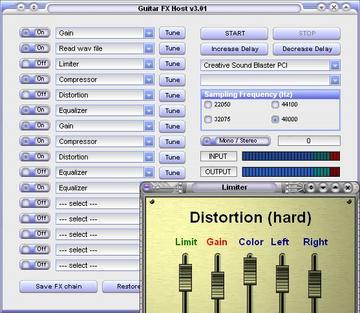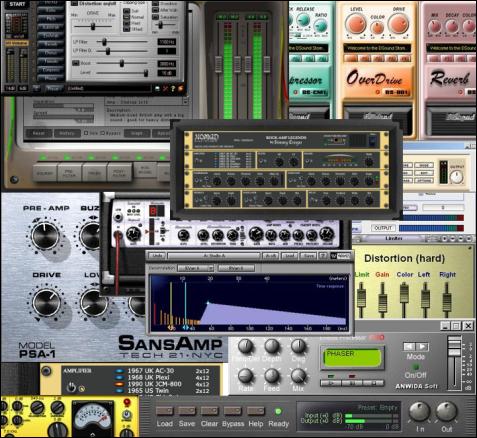Creating Professional Guitar Sound on PC

Download GuitarFX 3.04
Hear sound examples
and preset for Guitar FX 3.0 made by " FeNdEr"- Guitar as an electric signal source , guitar pickup's characteristics.
- How do Guitars Monsters make their great sound? Professional Analog guitar effects boxes, Ibanes Tube Screamer, Power Tube Amplifiers, Mesa Boogie, Marshall Guitar Speakers, SansAmp.
- Hardware Digital Audio Effects and Guitar Processors, BOSS, Digitech.
- Sound Cards for digitizing of guitar signals, signal to noise rations, non-linear distortions, my software audio card tester.
- Using Personal Computer for applying Effects to guitar signals, advances of 32 bit processing's in modern WAVE editors CoolEdit Pro, WaveLab, SAW, Sound Forge and ActiveX plug-ins.
- Noise problem, 60 Hz filter, white noise, noise reduction units
- Software Tube Amplifiers Simulators
- Software Analogue distortions simulators
- Equalizations, filters
- Flanger, Chorus, Pitch Shifter
- Software Reverb plug-ins, Waves, CoolEdit, WaveLab, My, Disk, comparisons
---------------------------------------------------------------------------------------------------------
Guitar as an electric signal source, guitar pickup's characteristics.
Guitar with pickups produces electric signals according to vibrations of guitar strings. The signal quality and properties depend of type of pickups and many other conditions. But pickups produce electric signals for further amplification and processing so I explain it in details.
Single Coil Pickup:
Old Fender pickups are single coil units. This compares to Gibson, which started using double coil (Humbucking) pickups in 1957. Single coil pickups have a single slab of wound wire around magnet(s). Single coil pickups are easily influenced by outside noise. This would include 60-cycle hum and fluorescent lights. Signal noise ration for this type of pickups is around 65..75 dB.Humbucking pickup: This type of pickup has two single coils combined into one unit. Each coil is reverse wound so that the hum from first coil cancels the hum from the second. Signal noise ration for this type of pickups is around 75..85 dB.
The longer the pickup wire and more turns used, the higher the resistance. Also the higher the resistance, the louder or "hotter" the pickup. But be aware, higher resistance comes at a cost: lose of treble frequencies. This is why single coil pickups have more treble and less output than Humbucking pickups (which use two coils). Hence Humbucking pickups have more mid-range and are "hotter". Also this is why single coil pickups that are wound with tons of wire (to approach Humbucking ohms) don't sound very good.
Usually pickups have the resistance around 5..9 kOhms and produce electric signals around 0.1..0.5 Volts. Both resistance and output voltage of guitar pickups are not very bad for microphone or line input of ordinal sound cards.
--------------------------------------------------------------------------------------------------------
How do Guitars Monsters make their great sound ?
Usually they use the typicall set of audio equipment. As a rule it consists of a tube pre-amp (ADA), analog solid circuit distortion box (Ibanes Tube Screamer or SansAmp), power tube amplifier (Mesa Boogie, Vox, Marshall), special guitar speakers (Marshall, Celestion) and microphone (Shure 57 etc.) placed in front of the speaker. All parts are essential. It is very important to note that guitar signal never is recorded directly from pre-amp or power amp output, but always from microphone.
For the meanest metal imaginable! Levels of grinding gain and singing sustain previously unattainable without the use of powerful tube amps at high volume. Hybrid tube/solid state distortion circuitry gets it all, from subtle overdrive to extreme saturation worthy of the blackest metal. Three-band equalization with a parametric mid to cover the sweet spot between 200-5kHz allows for a range of brutal tones, including the scooped mid sound of Metallica or Pantera. Where other distortions aren't enough, this kills.
Features: Hybrid tube/solid statge distortion circuitry
Three-band equalization with parametric mid control
Anonymous enthusiast wants to share excitement about finally discovered secret of elusive warm guitar tone he has sought for years. He has tried all sorts of rackmount preamps, power amps, effects units, combo amps, and so on. He has finally found the secret to a warm guitar sound; this may help others looking for the same classic warm guitar crunch and long, smooth sustain!
You can hear the sound examples in RealAudio format, created by Takaaki Yagi on similar set of audio equipments,
example1, exapmle2, example3.
Ibanez TS9 Tube Screamer Effects Pedal

Shure SM57 Instrument/Vocal Mic

Marshall JCM 800 Head and 1960AV Cab Half-Stack Package
The sound of this set of audio equipment is more of a straight rock sound like old Van Halen, Yngwie Malmsteen, George Lynch, AC/DC, and so on, rather than the modern highly fx-processed sounds of players such as Steve Vai, Satriani, and Petrucci. Of course you could add any effects you wish at the console.

Randall R412CX 4x12 Celestion Speaker Cab
Fig. 3. Typical Guitar Speakers.
Metallica's James Hetfield:
The last time I used a distortion [overdrive] pedal was on Ride the Lightning, and it was hell. It was an Ibanez Tube Screamer like Kirk uses. It really helps his solos cut through, but it puts a shitty coating on smooth rhythm tones, and it was hard to make it not sound like a pedal. You can recognize Marshall distortion in an instant; that's why I shied away from that and went with MESA/Boogies. I basically use the Boogie's distortion with a non-programmable studio-quality Aphex parametric EQ to fine-tune certain frequencies, dipping out some of the midrange. All my speakers are Celestion Vintage 30s."
Celestion Vintage 30 Speaker
Metallica is the cover story for Guitar Player Sep 1991, which I have. James: "I use a lot of mics... up to 8. I use them to phase-cancel each other, to control the sound like with an EQ but instead of an EQ. ... for the 1991 album, I'm using MESA Boogie amps, with ADA MP-1 tube preamp, but Boogie Simul-class II is the main part of the sound. Cabs: Boogie for clean, cutting stuff, Marshalls with 30 watt Celestion Vintage 30s for warmth."
---------------------------------------------------------------------------------------------------------
Hardware Digital Audio Effects & Guitar Processors

Rocktron VooDu Valve™ - Tube Guitar preamp plus Digital Processor
Sound Example
Digitech, BOSS, DOD, Roland and, may be, Zoom are very good looking things. Guitar Effects Processors have great functionality if you believe in words that manufacturers and magazines like "Guitar Player" are saying! But you understand they are advertisement words only. Note: Professional guitarists use Guitar Effects Processors not very often. Why? The real sounds from the devices are far from advertisement in guitar magazines. At the same time, why we can't find WAV or MP3 files with sound examples of such devices. I have scanned hard Internet and failed to find them, but I have found a lot of sound examples from different analogue solid state (transistors) and tubes based pre-amps, power amps and distortion boxes. Some famous Guitar Effects Processors use analogue and even Tube pre-amps and distortion sections!

Rocktron Prophesy Tube Guitar Preamp with Digial Effects

DigiTech Genesis 3 GeNetX Guitar Desktop Processor

Lexicon Omega Desktop Recording Studio
Lexicon has taken a whole-system approach to desktop recording. Omega Studio
is an integrated computer recording system that includes the Omega 8x4x2 USB I/O mixer,
ProTracks Plusú 32-track recording software,
and Pantheonú world-class Lexicon reverb plug-in. Omega Studio contains
all of the components necessary to transform your computer into a professional 24-bit recording studio. Whether you are a guitarist,
keyboard player, vocalist, instrumentalist or an audio engineer, Omega
Studio provides all the I/O mixing, recording and effects you need to
make your next project sound like it came from a professional studio. Sound Cards for guitar signal digitizing Sound cards for digitizing guitar signals A soundboard for all reasons!
Based on EWS88/MT/D technology it supports any software with ASIO 2.0, GSIF, or DirectSound drivers. The most demanding applications are supported with 24-bit/96kHz resolution and distortion separation of more than 101dB. With all the standard features of ordinary soundcards, it also gives you a MIDI connection.
The EWS 24 bit/96 kHz comes with the following software:
Gigasampler LE, Fruity Loops Express, Arturia Storm, Emagic Logic Fun,
Steinberg Wavelab(!) Lite, Buzz

Terratec EWX24/96 4 in / 4 out, $139, Mastering Soundcard
Using Personal Computer for applying Effects to guitar signals and achieve professional sound quality
The main problem after recording guitar signals via sound cards on hard disk of your personal computer in Windows
wav files is the Signal-to-Noise Ration. As you can read in previous part even the best sound cards record guitar signals with SNR not better than 65..80 dB. As you know, music CD in potential can have SNR=96 dB. It is better that we can achieve with sound cards. And note: 65 dB is not the professional value of SNR. That is why we must use special softwares like CoolEdit Pro.

Fig. 6. Typical electric guitar signal (Download WAV Editor) .
CoolEdit Pro has very good "Remove hiss" function. This function removes all audio in all frequencies that are below a certain threshold (generally the noise or hiss level). If audio has a constant background hiss (white noise hiss is removed most effeciently) then that hiss can be "noise gated" or removed completely. Any audio in any frequency band louder than the cutoff level will remain untouched. Use Hiss Reduction to remove annoying hiss from recorded guitar signals, cassette recordings, record albums (after click/pop removal), or microphone recordings.

Fig. 7. Hiss reduction function in CoolEdit Pro (Download it!) .
Guitar pickups as a magnetic device usually add in recorded signal 60 Hz circle hum. But CoolEdit Pro has several methods for removing such sort of noises.

Fig. 8. One of methods for removing 60 circle hum.
After noise reductions we obtain recorded guitar signals with professional Signal-to-Noise ration. Now we can start "to polish" our guitar sound! (But note: Many other authors recommend to do noise reductions after all effects processing). At first we can simulate tube pre-amplifiers using ActiveX plug-ins.
If your guitar has no good sustain you can add it using the function "Dynamics" in CoolEdit or one of the ActiveX "Compressor" plug-ins.
Modern Amp Modeling Software for Windows and Mac.

Shareware effects processor 1

Shareware tube modeling processor 2

Shareware amp modeling processor 3

Shareware effects processor 4

Shareware tube amp modeling processor 5

Shareware combo amp modeling processor 6

shareware effects processor 7

shareware amp modeling processor 8

shareware boxes modeling processor 9

Shareware amp modeling processor 10

Shareware amp modeling processor 11

Download all modern amp modeling shareware
in a single zip archive! (70 MB!!!)
-using VST plugins-
|
The World's best amp modeling Guitar Effects Processor must contain and use only the World's best effects and tube amp models!
It's impossible in the hardware (stompbox) world. Modern hardware guitar effects processors
contain only those effects and amp models developed by a single firm. Some firms can develop the best reverbs (say Lexicon),
but another firm can develop the best flangers (say DSP-FX) etc.
If you want to have the best guitar effects processor in the world you must be able to construct your own
using effects and tube amp models that are the best in the world. This is now possible by using the best software "fx building blocks" in the world.
Simply download these beautiful effects "plug-ins" or "fx building blocks" you can find on this site, then download any of free (or not)
fx players
and construct your own best guitar effects processor in the world!
Construction is simple. Run fx player, insert your chosen effects, connect the effects as you like and enjoy! 
Download graphEdt.exe (150 kB) Must have: DirectX 8 (12 MB) |
Other my Articles:
PC based Home Recording Studio
If you want to be informed about my NEW articles write empty letter to mailto:guitarfx-subscribe@yahoogroups.com (and reply on confirmation letter from this address)
May 2004










